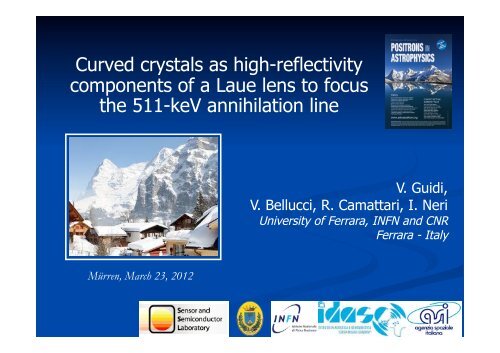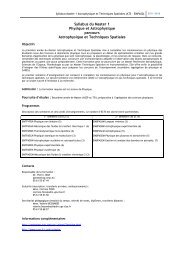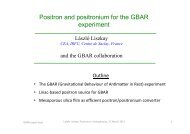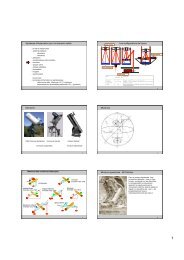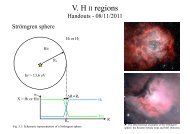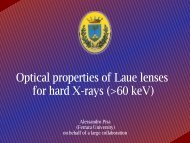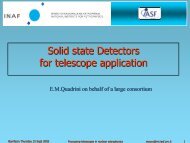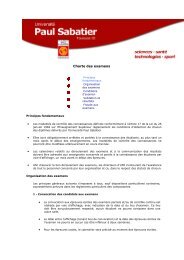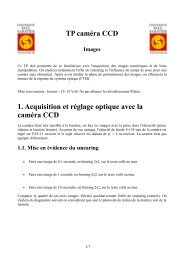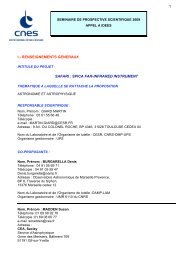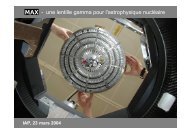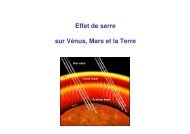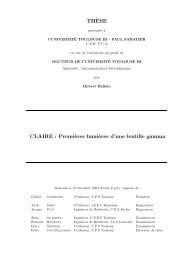Curved crystals as high-reflectivity components of a Laue lens ... - Cesr
Curved crystals as high-reflectivity components of a Laue lens ... - Cesr
Curved crystals as high-reflectivity components of a Laue lens ... - Cesr
You also want an ePaper? Increase the reach of your titles
YUMPU automatically turns print PDFs into web optimized ePapers that Google loves.
<strong>Curved</strong> <strong>crystals</strong> <strong>as</strong> <strong>high</strong>-<strong>reflectivity</strong><strong>components</strong> <strong>of</strong> a <strong>Laue</strong> <strong>lens</strong> to focusthe 511-keV annihilation lineV. Guidi,V. Bellucci, R. Camattari, I. NeriUniversity <strong>of</strong> Ferrara, INFN and CNRFerrara - ItalyMürren, March 23, 2012
Bragg geometry
Neutron beamdetector<strong>Curved</strong> crystalin Bragg geometrySample<strong>Curved</strong> <strong>crystals</strong> can be used <strong>as</strong> neutron monochromatorsover a wide energy band to analyze magnetic structure <strong>of</strong> materials
Channeling is confinement <strong>of</strong> charged particles travellingthrough a crystal by atomic planes or strings (planar oraxial mode)0.52Channeled particles in a bent crystal follow the curvature<strong>of</strong> the crystal thereby they are diverted like an equivalentmagnetic filed <strong>of</strong> thousands <strong>of</strong> Tesla would do!!!
Crystals fabricated atFerrara andexperimented at SPS(CERN)Phys Lett. B 692 (2010) 78
• Space-borne telescope toconcentrate radiation overselected energy bands in thehard x-ray/s<strong>of</strong>t γ domains.• Crystals are arranged <strong>as</strong>concentric rings to diffractradiation in <strong>Laue</strong> geometry fromcelestial sources to the focus.• Mosaic <strong>crystals</strong> are normallyconsidered for application<strong>Curved</strong> <strong>crystals</strong> allow focusing and concentrating<strong>high</strong>-energy x-rays at <strong>high</strong> diffraction efficiencyand incre<strong>as</strong>ing the energy bandwidth <strong>of</strong> the <strong>lens</strong>
<strong>Curved</strong> <strong>crystals</strong> for a <strong>Laue</strong> <strong>lens</strong>vs.
Scientific motivationsSources <strong>of</strong> positrons in galactic centerLow M<strong>as</strong>s x-ray binaries (LMXRB)?Dark Matter?
Imaging in nuclear medicine: SPECT<strong>Curved</strong> crystalOptics in LAUEgeometryDetectorGamma-raysourceDecay <strong>of</strong> 99m Tc to140 keV photons--99Mo 99m Tc + + e99mTc 99 Tc + <strong>Curved</strong> <strong>crystals</strong> would improve gamma-ray detection inSPECT with better resolution and lower radioactive doseto the patient than for the standard c<strong>as</strong>e with a gammacamer<strong>as</strong>ystem.
A <strong>Laue</strong> <strong>lens</strong> made <strong>of</strong> curved<strong>crystals</strong> would concentrate511-keV photons due toannihilationproviding <strong>high</strong>er resolutionwith respect to existinginstruments.Positron Emission Tomography schemeIt can work under eitherstandard radial or innovativeaxial geometry.
Self-standing bent <strong>crystals</strong> throughsurface groovingGrooved Si crystalOptical pr<strong>of</strong>ilometry <strong>of</strong>the surface without grooves
Principles and featuresN. Barrière, V. Guidi et al J. Appl. Cryst. 43 (2010) 1519
Me<strong>as</strong>urements at ESRF Grooved <strong>crystals</strong> were tested by x-ray diffraction <strong>of</strong> (111)planes in <strong>Laue</strong> geometry. Aim <strong>of</strong> the experiment w<strong>as</strong> to <strong>as</strong>sess the performance <strong>of</strong> such<strong>crystals</strong>A qu<strong>as</strong>i-parallel and <strong>high</strong>lymonochromatic pencil beamw<strong>as</strong> set at energy rangingfrom 150 to 700 keV.Me<strong>as</strong>urement consisted inRocking Curves.European Synchrotron Radiation Facility(Grenoble, France)V. Bellucci et al. Exp. Astron. 31 (2011) 45–58
Silicon samples(a)Beam qu<strong>as</strong>i-parallel to the grooves(b)Beam perpendicular to the grooves
Rocking Curves at 150 keVNormalized countsParallel configurationPerpendicular configurationz=0.4 mmz=0.15 mm13 ”z=0.8 mm93 %Angle <strong>of</strong> incidence (arcsec)53 %60 ”z=0.85 mmNormalized counts15 ”94 %54 ”71 %Angle <strong>of</strong> incidence (arcsec)
Discussion
Insight into the method <strong>of</strong>surface grooving
Efficiency vs. energybeam parallel to the grooves200 keV300 keVNormalized counts92 %84 %Normalized counts400 keVAngle <strong>of</strong> incidence (arcsec)68 %500 keV54 %Angle <strong>of</strong> incidence (arcsec)
Efficiency vs. energybeam perpendicular to the groovesNormalized countsNormalized counts200 keV400 keV300 keV59% 35%Angle <strong>of</strong> incidence (arcsec)500 keV24% 17%Angle <strong>of</strong> incidence (arcsec)
Parallel configurationPerpendicular configurationModel for a curved Si crystalModel for a mosaic Si crystal
Samples <strong>of</strong> germaniumzy xBeam qu<strong>as</strong>i-parallel to the grooves
Rocking curves at 300 keVNormalized countsz=0.25 mmz=0.85 mmz=1.25 mmAngle <strong>of</strong> incidence (arcsec)Normalized countsAngle <strong>of</strong> incidence (arcsec)Diffraction efficiencyaveraged 58%P<strong>as</strong>sband is determinedby the curvature
Possible configuration for a <strong>Laue</strong> <strong>lens</strong>x-ray beam[111]V. Bellucci et al. Exp. Astron. 31 (2011) 45–58See also poster presentation P20 by R. Camattari
Experimental results on Sistack at ILLAnalyzed at different y(110)y => 45 mm(111)x => 3 mm(110)y => 45 mm(111) x => 3 mm(211)z => 10 mm(211)z => 10 mmBeam set qu<strong>as</strong>i-parallel to the (220) planesBeam size: 10 x 1 mm 2Red arrow => X-ray beam
1) No misalignment 2) Critical misalignment3) Less important misalignment 4) Indifferent misalignment
Count450040003500300025002000150010005000Horizontal Average Cross Section176190204218232246260274288302316330344358372386400414428442456470484498512Pixels(111)x => 3 mm(110)y => 45 mm(211)z => 10 mmy=0mm(edge<strong>of</strong>themul0‐crystal)(220)planesarecoplanar,thuscri0calandindifferentmisalignmentscanbeexcluded
Count40003500300025002000150010005000Horizontal Average Cross Section176190204218232246260274288302316330344358372386400414428442456470484498512Pixels(111)x => 3 mm(110)y => 45 mm(211)z => 10 mmy=21mm(220)planesarecoplanar,thuscri0calandindifferentmisalignmentscanbeexcluded
Count300025002000150010005000Horizontal Average Cross Section176189202215228241254267280293306319332345358371384397410423436449462475488501Pixels(111)x => 3 mm(211)z => 10 mm(110)y => 45 mmy=38mmBeCerwelding<strong>of</strong>neighbouringplatesmustbedonenearthemul0‐crystaledge
Horizontal Average Cross SectionCount25002000150010005000176190204218232246260274288302316330344358372386400414428442456470484498512Pixels(111)x => 3 mm(110)y => 45 mm(211)z => 10 mmy=42mmBeCerwelding<strong>of</strong>neighbouringplatesmustbedonenearthemul0‐crystaledge
Count800070006000500040003000200010000Horizontal Average Cross Section182197212227242257272287302317332347362377392407422437452467482497Pixels(111) x => 3 mm(110)y => 45 mm(211)z => 10 mm Slitwidth:10x10mm 2Thebeamimpingesonthewholevolume<strong>of</strong>themul0‐crystalAlignment<strong>of</strong>(111)crystallineplanesbutmisalignment<strong>of</strong>(211)planes.Cri0calmisalignmentisexcluded
Configuration with focusingPhotonsV. Guidi et al. J. Appl. Cryst. 44 (2011) 1255-1258Angularspread
Qu<strong>as</strong>i-Mosaic <strong>crystals</strong> for <strong>high</strong>-resolution focusing <strong>of</strong> hard x-rays_________ R (QM) ≈ 2.4 for GeR (primary)_________R (QM)R (primary)≈ 2.6 for SiPrimary curvature: allows focalizationSecondary curvature (QM): incre<strong>as</strong>es the energy p<strong>as</strong>s-bandavoids the factor 1/2
<strong>Laue</strong> <strong>lens</strong> – Qu<strong>as</strong>i Mosaic CrystalsOne ringFocal plane
<strong>Laue</strong> <strong>lens</strong> – Qu<strong>as</strong>i Mosaic CrystalsOne ringFocal plane
Photons distributionon the focal plane – QM c<strong>as</strong>eCounts normalized to themosaic c<strong>as</strong>eFocal plane(meter)
Conclusions
Thank you foryour attention


